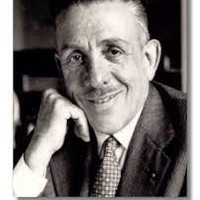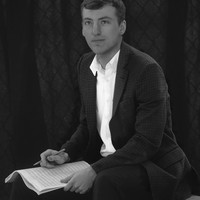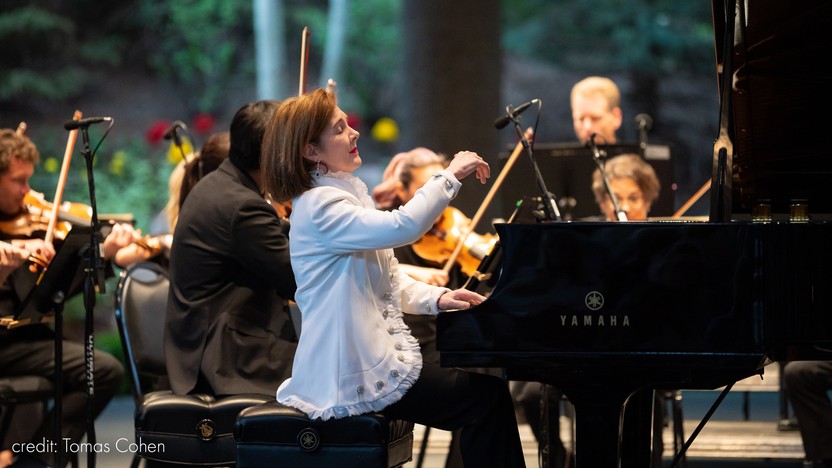Details

Francis Poulenc
Sextet for Piano and Wind Quintet (20 min)
Julia Bogorad-Kogan, flute
Cassie Pilgrim, oboe
Sang Yoon Kim, clarinet
Harrison Miller, bassoon
James Ferree, horn
Francis Poulenc was only 21 when he emerged among a crop of young French composers dubbed Les six, and yet he was well on his way to developing the musical personality that one critic would famously describe as “part monk, part rascal.” He was also a terrific pianist, and the extensive piano part he wrote (and performed) in the Sextet for Piano and Winds from 1932 is prime proof of his dexterity.
An initial “rascal” mood seems as if it will dominate the Sextet’s Allegro vivace first movement, but a bassoon interlude leads into a melancholy central section. The chattering excitement of the opening section returns briefly to bookend the movement. The middle movement, labeled a Divertissement, has a Classical tinge to its themes, with old-fashioned melodic turns and trills conveying a feeling of nostalgia. The finale continues the mood-shifting between bawdy playfulness and lush beauty, settling on the latter for a dreamy coda.
Aaron Grad ©2024

Chris Rogerson
Samaa’ (SPCO co-commission) (30 min) (World Premiere)
The first movement of the work was commissioned by Bravo! Vail in celebration of Anne-Marie McDermott and was premiered on June 25, 2022 by Anne-Marie McDermott and St. Paul Chamber Orchestra. The remainder of the work was commissioned by Anne-Marie McDermott and The Saint Paul Chamber Orchestra with support from Justus and Elizabeth Schlichting, and premiered at Ordway Concert Hall in St. Paul, Minnesota.
Much of my work is inspired by places and cultures around the globe that can feel remote to many Westerners like myself. I try to write music that reflects my own experiences in these places and my interpretation of what I often find to be beautiful and universal themes, rather than be the voice of people that live in circumstances much different from my own.
Samaa’ means “sky” in Arabic. In this work I had specific images in mind for each movement. First, I recently traveled to Yemen, a place I found to be almost mystical, saturated with beauty and mystery. But Yemen is in the midst of a decade-long conflict with devastating and long-term impact for Yemenis. I traveled with a man named Kais. Kais guides in Yemen to support 17 of his family members. On a long drive through the desert, he told me a story about how he once took a public bus through Houthi territory on the way to Sana’a, the capital, and how on the way he saw missiles falling from the sky. He told an elderly woman traveling next to him that the missiles were several kilometers away and that she should not worry.
This image of Kais and this woman traveling through a dangerous war zone, missiles raining down around them, is to me sweeping, moving, and epic: a testament to the lengths people can go simply to live their lives. And while just an image to me, it is something very real to them. It is something I cannot personally describe or attempt to portray. The fear they must have felt, the urgency, the overwhelming basic need to see their loved ones. And yet I am moved by it, moved to express how I feel about that image in the work that I create. This first movement, titled “Sky,” is generally solemn and reflective, with outbursts of energy called and answered by several “incantations” which occur throughout the movement.
The short interlude that follows, scored for the solo piano and percussion, is titled “Stars.” When I have trouble sleeping at night, sometimes I’ll think about the stars I’ve seen in the most remote of places, in jungles and plains and mountains. This feeling of knowing I’m sleeping under the same sky I saw then grounds me and gives me some small comfort.
The final movement, “Moon,” is another specific memory, of a night I had in Iran traveling with my friend Jacob and our guide Abdullah. We had visited the ancient ruins of Persepolis that day and were staying at a 1000-year old caravanserai, where Silk Road traders would trade and park their camels to rest overnight. At some point, Abdullah reached into his trunk and pulled out a jug of wine he and his mother had made together in Shiraz (alcohol is illegal in Iran). We drank the wine underneath an arch from the era of Persepolis as the moon shone above us, talking about everything, life, love, travel, loss.
This piece is not a personal travelogue, or a love letter to places I’ve visited or people I’ve met. It’s an attempt to portray the poignancy and beauty of what I felt in moments while in other worlds, to evoke the mystery and magic and continuity of the sky, and a broader humanity that we all share.
Chris Rogerson ©2024

Ernest Chausson
Concerto for Piano, Violin and String Quartet (37 min)
Kyu-Young Kim, violin
Steven Copes, violin
Eunae Koh, violin
Maiya Papach, viola
Julie Albers, cello
Ernest Chausson only embraced music in his early twenties, defying his father’s wishes that he practice law. He enrolled at the Paris Conservatory where he studied with César Franck and Jules Massenet, and he also fell under the sway of Richard Wagner, whose operas he heard firsthand in Bayreuth in 1879 and 1880. Chausson was able to live off his father’s fortune while he developed his musical voice at his own pace, including the eight years he spent writing his largest work, an opera on the subject of King Arthur.
Amid work on that opera, Chausson spent two years drafting the Concerto for Piano, Violin, and String Quartet, his first foray into chamber music since the Piano Trio he wrote as a student. By labeling it Concert (to use the French term), Chausson was not proclaiming this music to be a concerto in the Romantic sense of a work for soloist and orchestra; instead he was evoking the Baroque tradition of a group concerto or concerto grosso, in which several featured instruments interact with a larger ensemble. Chausson convinced the superstar Belgian violinist Eugène Ysaÿe, a Franck ally, to introduce the work in Brussels in 1892.
Chausson took after Franck in favoring large, cyclical forms derived from a unifying theme. To begin the Concerto, a three-note motive sounds twice, with a performance instruction that translates as “determined” or “purposeful.” Those same three notes initiate a calm introduction, and they also launch the animated body of the movement, heading a theme introduced by the solo violin and piano.
The short second movement is a Sicilienne, a dance style that harks back to the Baroque era, with a main theme that rocks between the first and last notes of the three-note motto. In the Grave third movement, the quartet often rests while the violin and piano play in the manner of a sonata. The primary melody slinks downward in a series of slow sighs — again evoking the Baroque era through this typical gesture of a Lament — while the piano gradually elaborates and accelerates an alluring pattern of sinking and rising chromatic tones. The wide-ranging finale completes this cyclical form by referencing earlier themes, including the all-important three notes from the beginning.
Aaron Grad ©2024
About This Program
Anne-Marie McDermott, “a pianist who balances qualities of excitement and spontaneity with clarity and elegance” (New York Times), reunites with the SPCO for the first time since their fruitful collaboration at the 2022 Bravo! Vail Music Festival in Colorado. McDermott will lead the orchestra once again in a world premiere of Chris Rogerson’s Samaa', a new expansion of his work by the same name that was previously recorded in Colorado. Two chamber works by French composers showcase the piano in chamber ensembles — an impressionistic concerto with strings by Ernest Chausson and a sextet with winds by Francis Poulenc that pendulates between liveliness and elegy.
This expanded version of Samaa’ was commissioned by The Saint Paul Chamber Orchestra with support from Anne-Marie McDermott and Elizabeth and Justus Schlichting.
Contribute
SPCO concerts are made possible by audience contributions.
Newsletter
For exclusive discounts, behind-the-scenes info, and more:
Sign up for our email club!

